Temperate Deciduous Forest Climate Graph
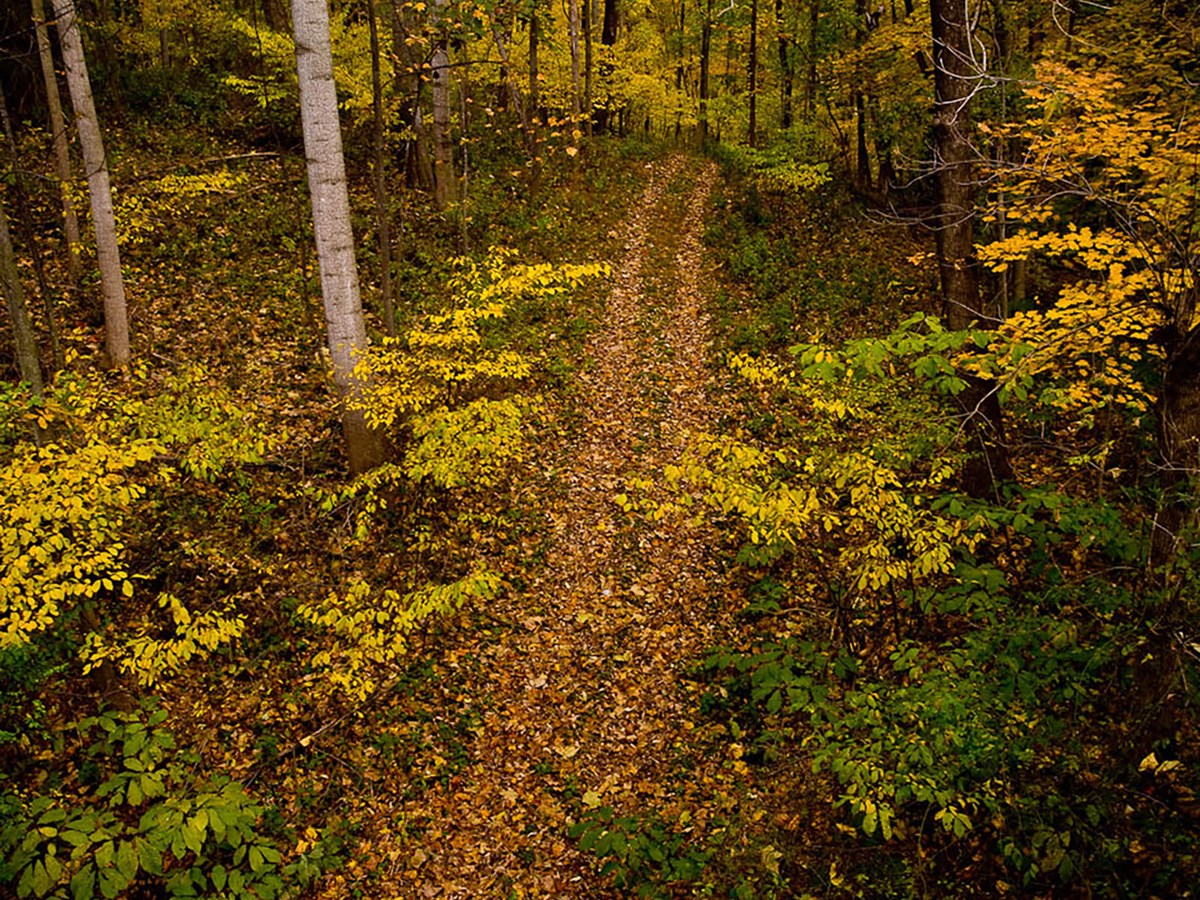
NPS/Thomas Paradis
Overview
The parks of the National Capital Region Network (NCRN) are a fascinating drove of natural areas that fall within the immense Eastern Deciduous Forest ecosystem.
North America'southward Eastern Deciduous wood ecosystem stretches over 26 states from Florida up to New England and southern Canada, and extends as far westward as Texas and Minnesota. These forests are dominated by broad-leafed copse that shed their leaves annually (deciduous), with evergreen cone-bearing seed plants (conifers) such equally pines and hemlocks common in some areas.
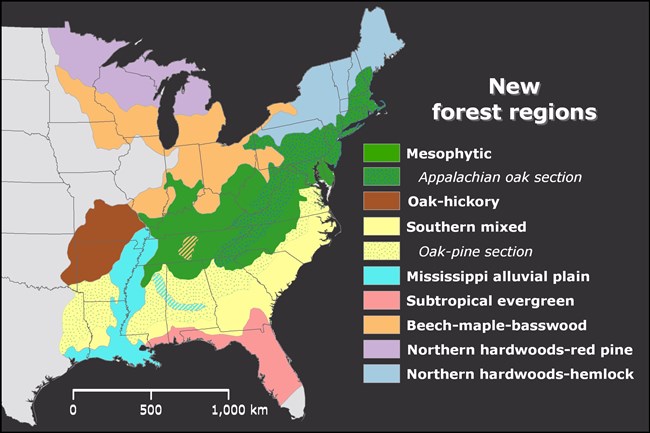
Dyer 2006
The Eastern Deciduous wood once occupied virtually ii,560,000 km2 (Delcourt and Delcourt 2000). For thousands of years its unbroken expanse was dominated by oaks, chestnuts, and hickories that provided valuable food and shelter for wildlife. The 18th and 19th centuries brought unprecedented changes as forest was cleared for agriculture, timber, fuelwood, and urban expansion.
Despite these and many other challenges, parts of the Eastern Deciduous Forest in the southern and Mid-Atlantic U.S. are recognized equally high priorities for worldwide conservation. 2 parts of the Eastern Deciduous wood in the NCRN, the Southern Coniferous and Broadleaf Forests and the Appalachian and Mixed Mesophytic Forests, were chosen equally part of the "Global 200" listing of areas important for global conservation. These areas were selected for recognition for their high biodiversity and their large surface area compared to similar forests worldwide.

NASA Globe Observatory
Climate
The Eastern Deciduous forest is a type of "temperate deciduous forest." These forests occur across the world in the mid-latitudes (betwixt the tropics and the polar regions) in western Europe, eastern Asia, southwestern S America, and the eastern U.S. They are distinguished by warm and cold air masses that cause four singled-out seasons a yr. Trees change color and lose their leaves in fall as temperatures and precipitation levels driblet. Winters accept low precipitation levels and cold temperatures, and trees and other plants are inactive. In spring, temperature and precipitation levels rise causing plants to break dormancy and new growth and flowering to flare-up forth. In summer, plants of temperate deciduous forests grow the near, fueled by the warmest temperatures and highest precipitation levels of the entire year.
Geology and Topography
The vast majority of NCRN lies within the Potomac River watershed. The Potomac is the 2d-largest tributary of the Chesapeake Bay—America's largest estuary. The parks of the NCRN have a diverse array of natural forest communities determined in part by a wide range of underlying soils, geology, and topography. In the eastern U.Southward., these foundational groupings typically occur as north-south bands parallel to the Atlantic declension and the Appalachian Mountains.
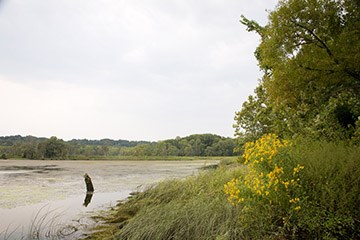
NPS/Thomas Paradis
Coastal Plain
The easternmost portion of the NCRN, the Littoral Obviously is the mostly flat and low lying surface area between the Atlantic Ocean and the foothills of the Appalachian Mountains. It is fabricated from layers of sediment primarily eroded from the Appalachian Mountains and deposited by rivers as sediment over the Coastal Apparently.
The parks that make up National Capital Parks - Eastward, parts of the George Washington Memorial Parkway, and a portion of Prince William Wood Park all fall within the Coastal Plain.
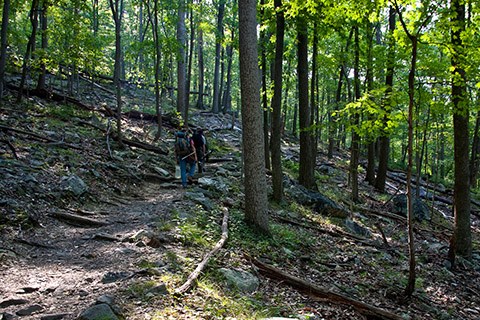
NPS/Thomas Paradis
Blue Ridge
To the westward of the Piedmont is the narrow Blueish Ridge region. Information technology encompasses the Blue Ridge Mountains, the easternmost part of the Appalachians. Its rocks are the oldest in the National Majuscule Region. They formed over millions of years as an ancient body of water floor was folded, smashed, and pushed up into the Appalachian Mountains, which at the fourth dimension soared to heights resembling the mod Himalayan range. Erosion during the following 265 one thousand thousand years cut down the once towering mountains to their mod elevations, and exposed rocks that were once buried deep inside the cadre of the mount belt. The Blue Ridge is typified by steep terrain covered by sparse, shallow soils.
NCRN parks in the Bluish Ridge include Catoctin Mountain Park, Harpers Ferry National Historical Park, and a small section of the C&O Culvert National Historical Park.
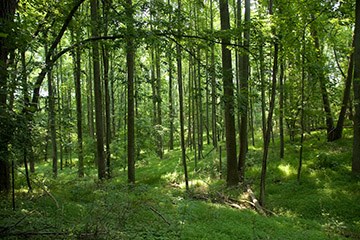
NPS
Ridge and Valley
The westernmost physiographic region in the NCRN is the Ridge and Valley, which makes upwards part of the Appalachian Mountains. Its parallel ridges are made of rocks that are more resistant to erosion than those of the valleys. Therefore, the ridges remained as high points on the mural, while the valleys were eroded into gently sloping lows. Areas with carbonate bedrock formations (e.1000. limestone) have "karst" topography that can include sinkholes, underground streams, and caves.
All of Antietam National Battlefield, parts of Harpers Ferry National Historical Park, and much of the C&O Canal National Historical Park are within the Ridge and Valley.
Forests Characteristics and Species
The Eastern Deciduous Wood awning is dominated past oaks (Quercus), hickories (Carya), tulip poplar (Liriodendron tulipifera), American beech (Fagus grandifolia), "hard maples" (Acer spp.), and basswood (Tilia). Of import conifers are eastern hemlock (Tsuga canadensis) and eastern white pine (Pinus strobus). All of these are species mutual in the NCRN except for eastern white pino and eastern hemlock, which is in pest- and disease-related decline. American chestnut (Castanea dentata), formerly dominant throughout the Eastern Deciduous wood, was virtually eliminated by illness in the early on twentieth century.
Based on the the iv geologic and topographic areas described to a higher place, forests in each NCRN park have somewhat dissimilar types of forest and tree species. For example, American holly (Ilex opaca) is common on the Coastal Plainly and Piedmont, but largely absent from the more western Blue Ridge and the Ridge and Valley. Chestnut oak (Quercus prinus) is found in many NCRN parks, but is about common in Catoctin Mountain Park and Harpers Ferry National Historical Park, in the Blue Ridge.
It is also possible to expect at forests at an fifty-fifty finer scale of "natural communities." For instance, Stone Creek Park is a Piedmont forest in a highly urbanized environment. Forests inside Rock Creek have been mapped and described in great item to the natural community level.
Land Use History and Protection
Most of the land in eastern U.S. has been logged or cultivated at some bespeak in the recent by. It is estimated that only 0.1% of this area was undisturbed, 82.half dozen% was homo dominated, and the residue were lands with some disturbance (logging, 2d–growth forests on abandoned subcontract fields, etc.). The forests that do remain are often found in smaller fragments. In the NCRN, the forests are typically surrounded by urban or agricultural areas. The surrounding lands take the potential to introduce invasive species or foreclose the move of native species.
Prior to the 1900s fires were common in Eastern Deciduous Forests. In the NCRN, fires were frequent, but low intensity, primarily affecting the understory. Currently, due to burn suppression, fires are less frequent, and this tin have profound impacts on woods vegetation. In general, the lack of burn in eastern forests benefits plants that tolerate shade, just are vulnerable to burning. These include maples, American beech, mount laurel, and many others. Fire suppression is detrimental to species that tolerate fires but not shade. These include oaks, hickories, and pines. Further complicating this situation is the touch on of browsing past white-tailed deer (Odocoileus virginianus). Deer are more abundant now than they were historically. This loftier abundance of deer can modify forest community composition, as deer preferentially scan on some tree species, such every bit oaks and hickories.
Understanding Modify
NCRN'due south long–term monitoring is designed to help us understand how our forests are changing. Today, forest fragmentation, overabundant deer populations, exotic species, pollution, fire suppression, acrid pelting and other changes in atmospheric chemistry, and human-induced climate change all threaten NCRN forests. The American chestnut has been nigh eliminated by an exotic pathogen and ashes are imminently threatened by an exotic borer beetle. Oaks and hickories are in refuse while the shade-tolerant beech ( Fagus grandifolia ) and maples ( Acer spp.), which concord less value for wildlife, are becoming dominant. Exotic species, deer, and fire suppression are likely driving these changes. Yet, NCRN parks are withal refuge for a wide range of plant and animate being life, dwelling house to rare natural communities, and offering visitors the opportunity to feel the natural environment in a relatively urbanized area.
References
Coladonato, M. 1991. Fagus grandifolia. In: Fire Effects Information System, [Online]. U.S. Department of Agriculture, Woods Service, Rocky Mountain Enquiry Station, Burn Sciences Laboratory (Producer). [2012, Jan 9]
Côté S.D., T. P. Rooney, J.-P. Tremblay, C. Dussault, and D. M. Waller. 2004. Ecological impacts of deer glut. Annual Review of Ecology, Evolution and Systematics. 35:113-147.
Delcourt, H. R. and P. A. Delcourt. 2000. Eastern deciduous forests. Pages 357â€"395 in M. G. Barbour and W. D. Billings. editors. North American terrestrial vegetation. 2nd edition. Cambridge University Press, Cambridge, UK.
Dyer, J. 2006 Revisiting the Deciduous Forests of Eastern North America. BioScience. Vol 56, Issue 4. Pp. 341-352.
Fei, S., and P. Yang. 2011. Woods composition alter in the eastern United States. In: Fei, Songlin; Lhotka, John Yard.; Stringer, Jeffrey Due west.; Gottschalk, Kurt Westward.; Miller, Gary Due west., eds. Proceedings, 17th primal hardwood wood conference; 2010 Apr 5-vii; Lexington, KY; Gen. Tech. Rep. NRS-P-78. Newtown Foursquare, PA: U.S. Section of Agriculture, Forest Service, Northern Research Station: 103-108.
Hannah, 50., D. Lohse, C. Hutchinson, J. L. Carr and A. Lankerani. 1994. A preliminary inventory of man disturbance of World Ecosystems. Ambio 23:246â€"250.
League, Grand. R. 2005. Kalmia latifolia. In: Burn down Effects Information System, [Online]. U.South. Department of Agriculture, Wood Service, Rocky Mountain Enquiry Station, Fire Sciences Laboratory (Producer). [January 9, 2012].
Nowacki, G. J. and Yard. D. Abrams. 2008. The demise of burn and the "mesophication" of forests in the eastern United States. Bioscience 58:123-138.
Olson, D. M., and E. Dinerstein. 2002. The Global 200: Priority ecoregion for global conservation. Annals of the Missouri Botanical Garden 89: 199-224.
Temperate Deciduous Forest Climate Graph,
Source: https://www.nps.gov/im/ncrn/eastern-deciduous-forest.htm
Posted by: lewispaince.blogspot.com


0 Response to "Temperate Deciduous Forest Climate Graph"
Post a Comment